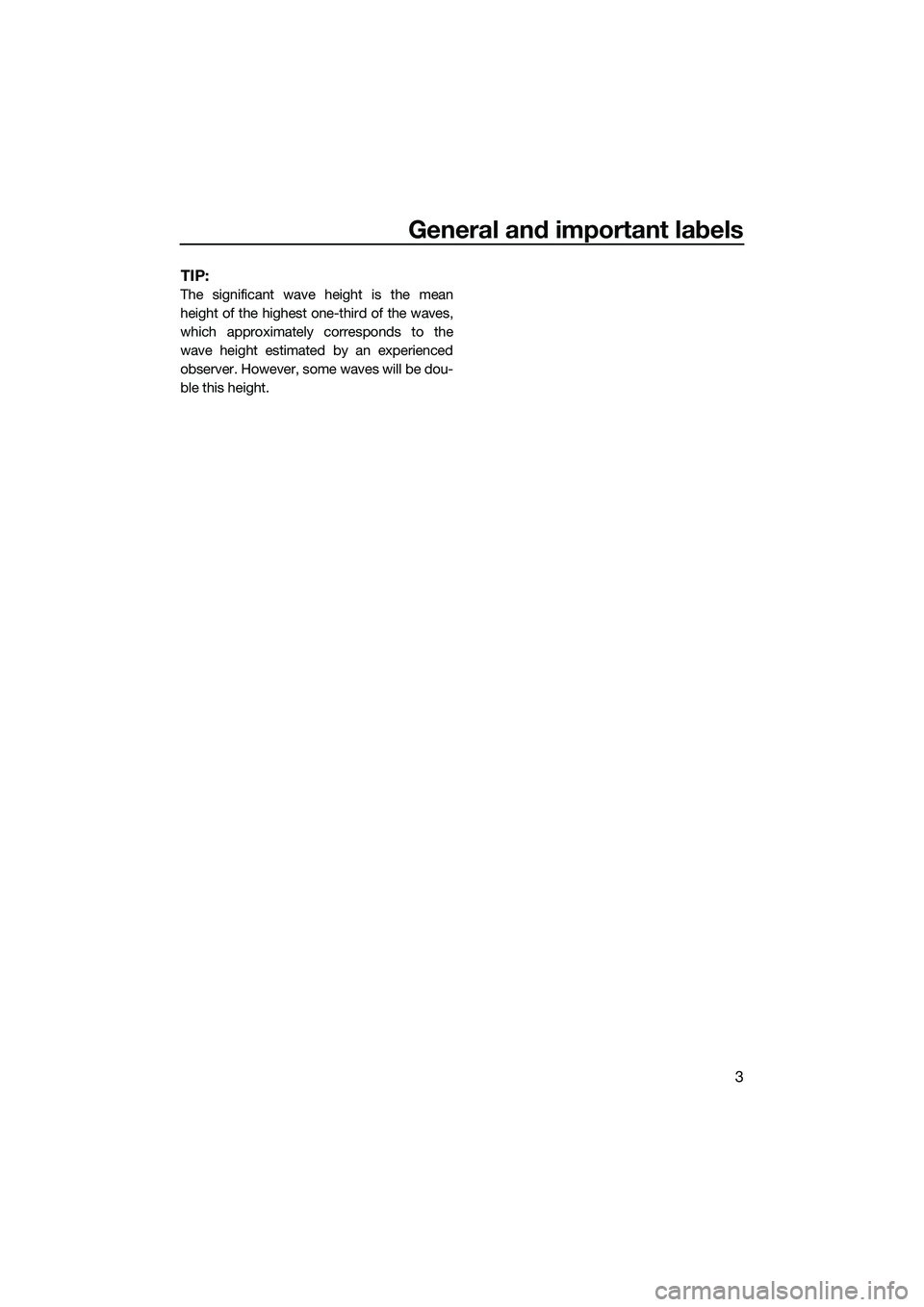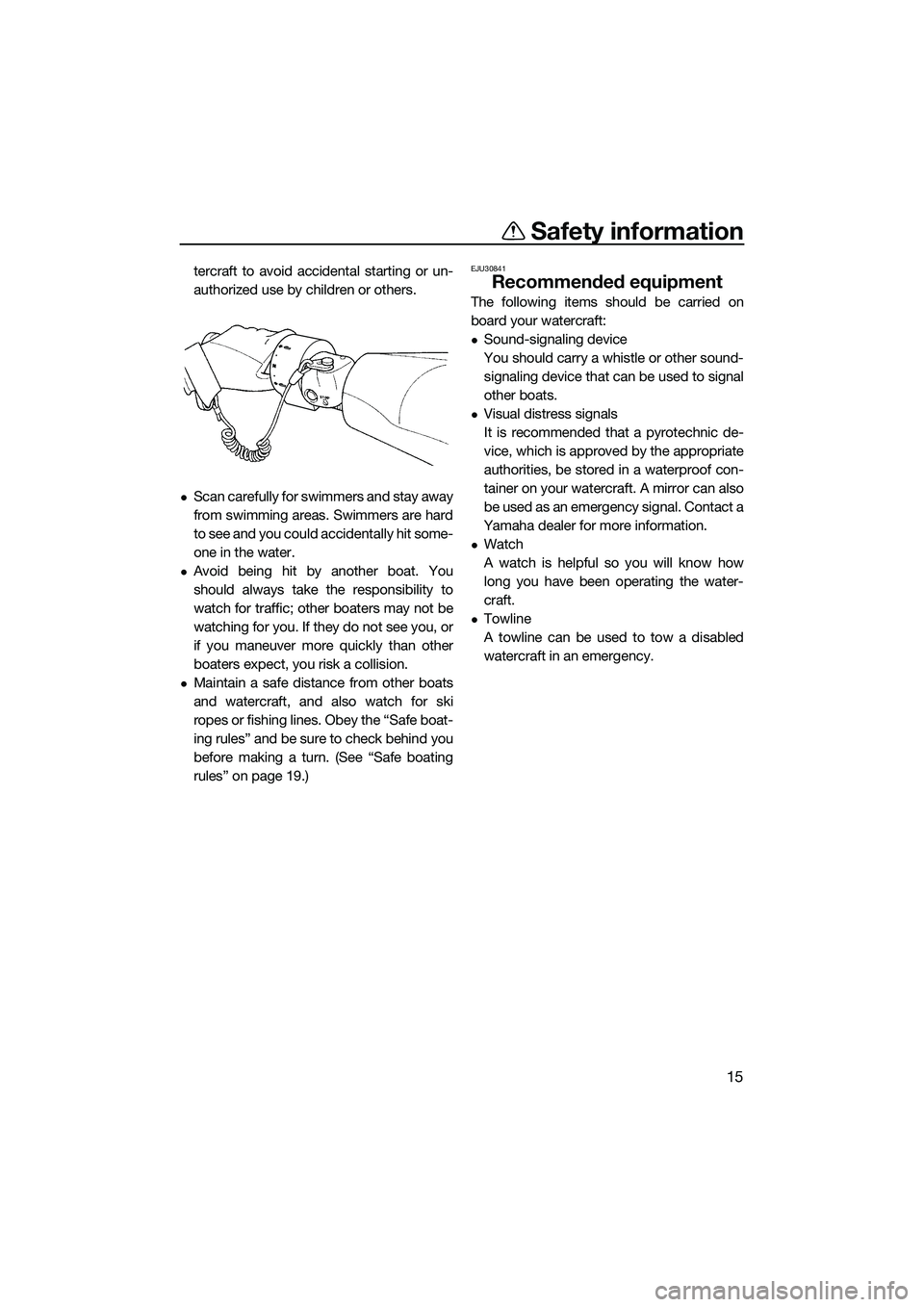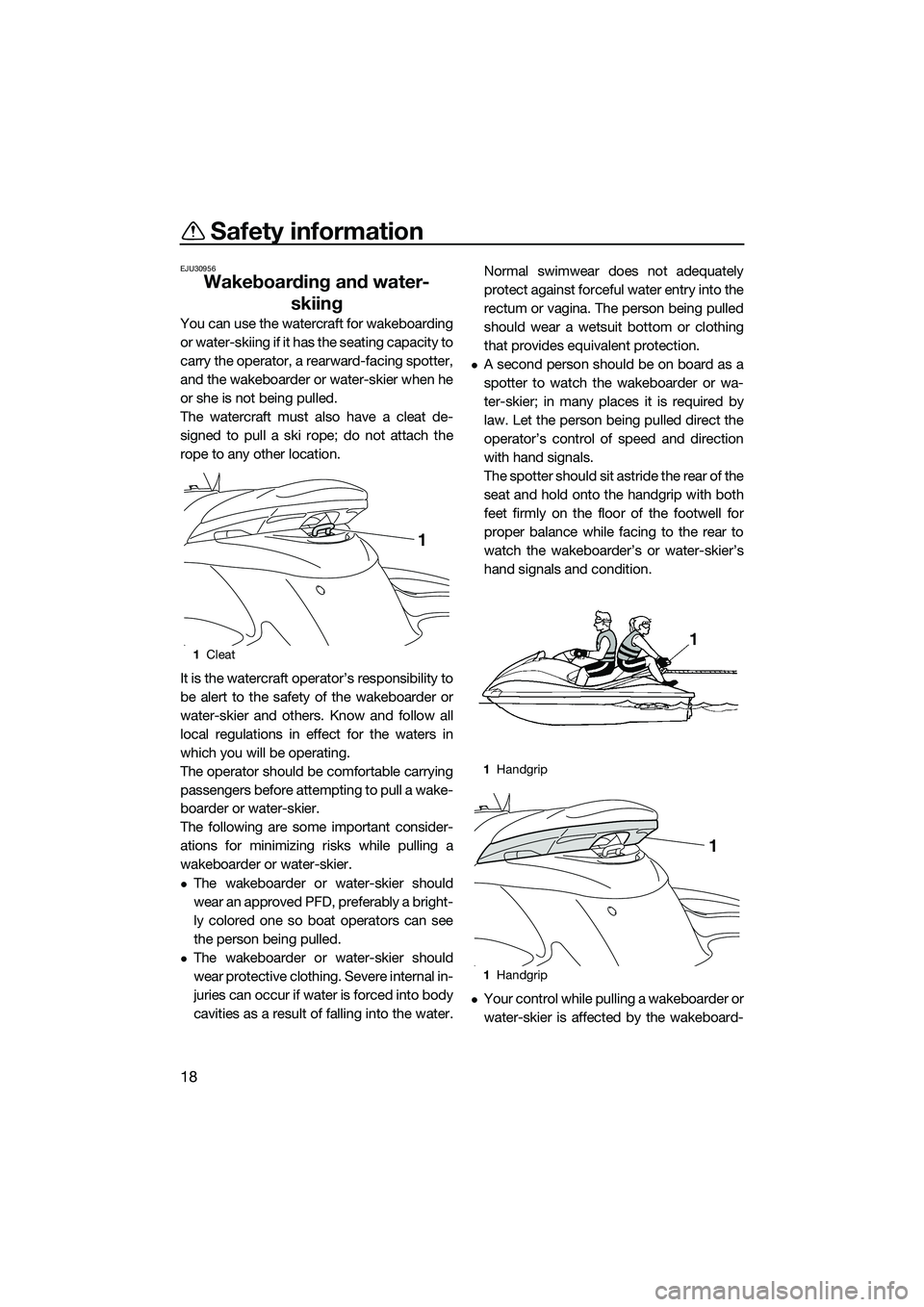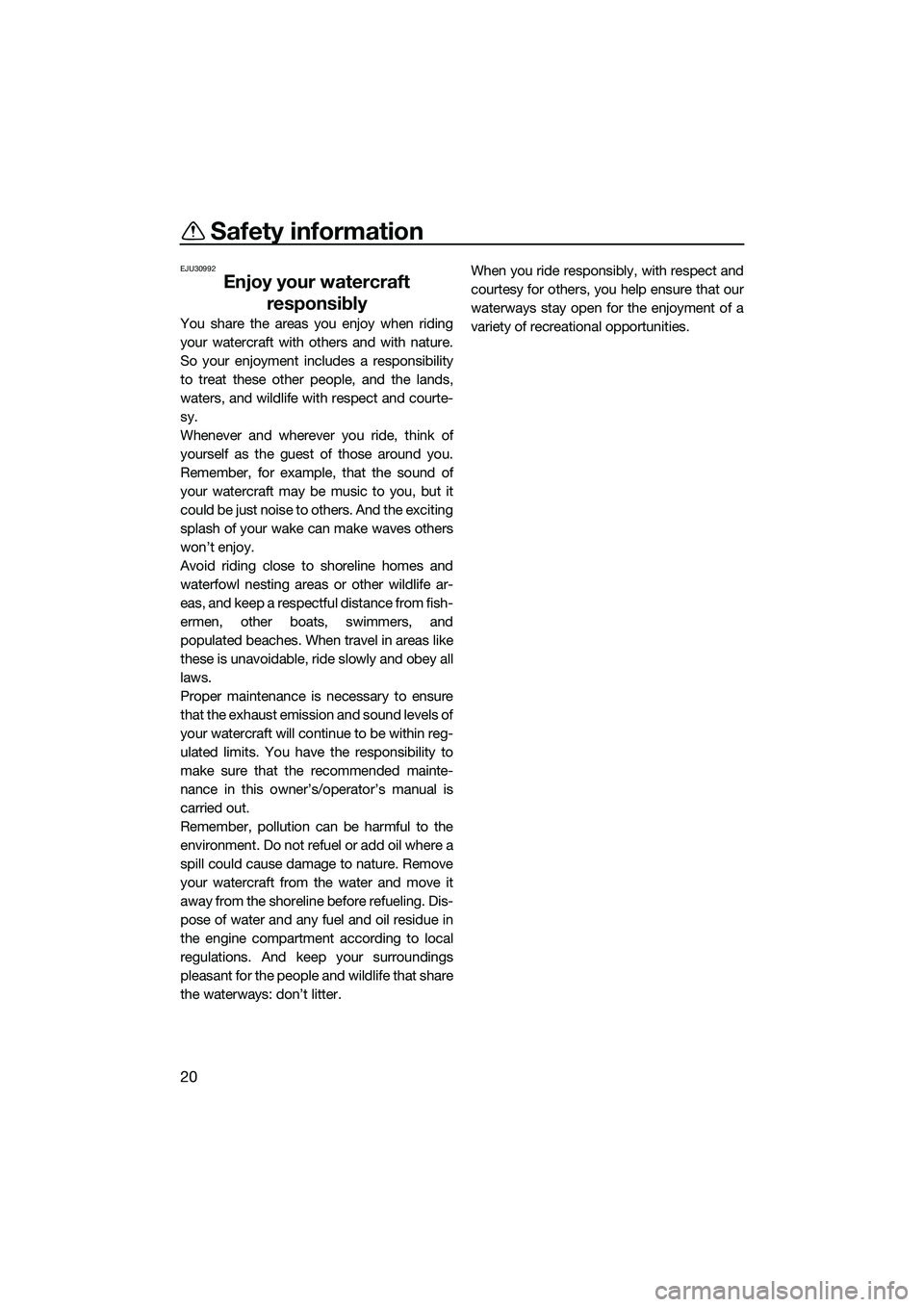2015 YAMAHA FZS SVHO ESP
[x] Cancel search: ESPPage 3 of 106

Important manual information
EJU42741
Declaration of Conformity for Personal Watercraft (PWC)
with the requirements of Directive 94/25/EC, as amended by Directive 200\
3/44/EC
Name of PWC Manufacturer: YAMAHA MOTOR CO., LTD.
Name / Title:Y. Henmi / General Manager of Engineering Section, WV Business Unit
Address:
2500 Shingai, Iwata, Shizuoka 438-8501, Japan
Name of Authorised Representative: YAMAHA MOTOR EUROPE N.V.
Address: Koolhovenlaan 101, 1119 NC Schiphol-Rijk, The Netherlands
Name of Notified Body for exhaust and noise emission assessment: SNCH
GX1800A-P / FZS SVHO 0499
ID Number:
Address: 11, route de Luxembourg BP 32, Sandweiler, L-5230. Luxembourg
US-YAMA1001H415
Conformity assessment module used:
for construction:
for exhaust emissions:
for noise emissions:
DESCRIPTION OF CRAFT
DESCRIPTION OF ENGINE A
A
Craft model Identification Number, starting from :
Model name / Commercial name : C
Design Category : Other Community Directives applied
Directive 2004/108/EC relating to electromagnetic compatibility (EMC).\
CISPR 12
Directive 2006/42/EC relating to Machinery. Standards
EN 61000-6-2
D
Aa
AaB+C
B+CB+D
B+D B+E
B+EB+F
B+FG
G
GH
H
H
Engine Type:
PWC engine Combustion cycle:
4 stroke
Fuel Type:
Petrol
ESSENTIAL REQUIREMENTS
IDENTIFICATION OF ENGINE COVERED BY THIS DECLARATION OF CONFORMITY
Name of engine model
6EV Name / ID number of Notified Body
SNCH / 0499
EC Type–examination certificate number
SNCH*94/25*2003/44*0076
(identification of the person empowered to sign on behalf of the manufa\
cturer)
Signature:(or an equivalent marking)Date and place of issue:1st / August / 2014, Shizuoka, Japan
Essential requirements
standardsother normative
document / method technical filePlease specify in more detail
(* = mandatory standard)
I.A design and construction EN ISO 13590
I.B exhaust emission *EN ISO 8178-1
I.C noise emission *EN ISO 14509
*
*
This declaration of conformity is issued under the sole responsibility o\
f the manufacturer. I declare on behalf of the PWC
manufacturer that the craft model(s) and engine(s) mentioned above c\
omplies (comply) with all applicable essential
requirements in the way specified and is (are) in conformity with the \
type(s) for which above mentioned EC type-examination
certificate(s) has (have) been issued.
ID Number:
UF3K71E0.book Page 1 Monday, August 18, 2014 2:54 PM
Page 5 of 106

Table of contents
General and important labels ........... 1Identification numbers .................... 1
Primary Identification (PRI-ID)
number............................................ 1
Craft Identification Number (CIN) ....... 1
Engine serial number.......................... 1
Manufactured date label .................... 2
Model information ........................... 2
Builder’s plate .................................... 2
Important labels .............................. 4
Warning labels.................................... 5
Other labels ........................................ 9
Safety information ........................... 11 Limitations on who may operate the watercraft ............................. 11
Cruising limitations ........................ 12
Operation requirements ................ 13
Recommended equipment ........... 15
Hazard information........................ 16
Watercraft characteristics ............. 16
Wakeboarding and water-skiing ... 18
Safe boating rules ......................... 19
Enjoy your watercraft responsibly ................................. 20
Description....................................... 21 Watercraft glossary ....................... 21
Location of main components ...... 22
Control function operation ............. 26 Watercraft control functions ......... 26
Remote control transmitter .............. 26
Yamaha Security System ................. 27
Engine stop switch .......................... 28
Engine shut-off switch .................... 28
Start switch ..................................... 28
Throttle lever .................................... 29
Steering system ............................... 29
Telescopic steering system.............. 30
Cooling water pilot outlets ............... 30
Water separator................................ 31
Watercraft operation ...................... 32Watercraft operation functions ..... 32
Reverse system ................................ 32
Quick Shift Trim System
(Q.S.T.S.) ....................................... 32
Watercraft operation modes ......... 34
Low RPM Mode ............................... 34
Instrument operation ...................... 36Dual analog meter unit.................. 36
Speedometer.................................... 36
Tachometer ...................................... 36
Information display ........................... 37
Equipment operation ...................... 41Equipment..................................... 41
Seats ................................................ 41
Handgrips ......................................... 42
Reboarding grip................................ 42
Reboarding step ............................... 42
Bow eye............................................ 43
Stern eyes ........................................ 43
Cleat ................................................. 43
Storage compartments .................... 44
Fire extinguisher holder and cover ... 47
Operation and handling
requirements ................................... 49Fuel requirements ......................... 49
Fuel................................................... 49
Engine oil requirements ................ 51
Engine oil .......................................... 51
Draining the bilge water ................ 52
Draining the bilge water on land....... 52
Draining the bilge water on water .... 53
Transporting on a trailer................ 54
First-time operation ........................ 55 Engine break-in............................. 55
Pre-operation checks ..................... 56
Pre-operation checklist .................... 56
UF3K71E0.book Page 1 Monday, August 18, 2014 2:54 PM
Page 9 of 106

General and important labels
3
TIP:
The significant wave height is the mean
height of the highest one-third of the waves,
which approximately corresponds to the
wave height estimated by an experienced
observer. However, some waves will be dou-
ble this height.
UF3K71E0.book Page 3 Monday, August 18, 2014 2:54 PM
Page 21 of 106

Safety information
15
tercraft to avoid accidental starting or un-
authorized use by children or others.
Scan carefully for swimmers and stay away
from swimming areas. Swimmers are hard
to see and you could accidentally hit some-
one in the water.
Avoid being hit by another boat. You
should always take the responsibility to
watch for traffic; other boaters may not be
watching for you. If they do not see you, or
if you maneuver more quickly than other
boaters expect, you risk a collision.
Maintain a safe distance from other boats
and watercraft, and also watch for ski
ropes or fishing lines. Obey the “Safe boat-
ing rules” and be sure to check behind you
before making a turn. (See “Safe boating
rules” on page 19.)
EJU30841
Recommended equipment
The following items should be carried on
board your watercraft:
Sound-signaling device
You should carry a whistle or other sound-
signaling device that can be used to signal
other boats.
Visual distress signals
It is recommended that a pyrotechnic de-
vice, which is approved by the appropriate
authorities, be stored in a waterproof con-
tainer on your watercraft. A mirror can also
be used as an emergency signal. Contact a
Yamaha dealer for more information.
Watch
A watch is helpful so you will know how
long you have been operating the water-
craft.
Towline
A towline can be used to tow a disabled
watercraft in an emergency.
UF3K71E0.book Page 15 Monday, August 18, 2014 2:54 PM
Page 22 of 106

Safety information
16
EJU36851
Hazard information
Never start the engine or let it run for any
length of time in an enclosed area. Exhaust
fumes contain carbon monoxide, a color-
less, odorless gas that may cause loss of
consciousness and death within a short
time. Always operate the watercraft in an
open area.
Do not touch the hot muffler or engine dur-
ing or immediately after engine operation;
they can cause serious burns.
EJU30921
Watercraft characteristics
Jet thrust turns the watercraft. Releasing
the throttle lever completely produces only
minimum thrust. If you are traveling at
speeds above trolling, you will have rapidly
decreasing ability to steer without throttle.
This model is equipped with the Yamaha
Engine Management System (YEMS) that
includes an off-throttle steering (OTS) sys-
tem. It will activate at planing speeds
should you attempt to steer the watercraft
after releasing the throttle lever. The OTS
system assists in turning by continuing to
supply some thrust while the watercraft is
decelerating, but you can turn more sharp-
ly if you apply throttle while turning the han-
dlebars.
The OTS system does not function below
planing speeds or when the engine is off.
Once the engine slows down, the water-
craft will no longer turn in response to han-
dlebar input until you apply throttle again or
you reach trolling speed.
Practice turning in an open area without
obstacles until you have a good feel for this
maneuver.
This watercraft is water-jet propelled. The
jet pump is directly connected to the en-
gine. This means that jet thrust will produce
some movement whenever the engine is
running. There is no “neutral” position. You
are in either “forward” or “reverse”, de-
pending upon the shift lever position.
Do not use the reverse function to slow
down or stop the watercraft as it could
cause you to lose control, be ejected, or
impact the handlebars.
This could increase the risk of back/spinal
injury (paralysis), facial injuries, and broken
legs, ankles, and other bones. You could
also damage the shift mechanism.
UF3K71E0.book Page 16 Monday, August 18, 2014 2:54 PM
Page 24 of 106

Safety information
18
EJU30956
Wakeboarding and water-skiing
You can use the watercraft for wakeboarding
or water-skiing if it has the seating capacity to
carry the operator, a rearward-facing spotter,
and the wakeboarder or water-skier when he
or she is not being pulled.
The watercraft must also have a cleat de-
signed to pull a ski rope; do not attach the
rope to any other location.
It is the watercraft operator’s responsibility to
be alert to the safety of the wakeboarder or
water-skier and others. Know and follow all
local regulations in effect for the waters in
which you will be operating.
The operator should be comfortable carrying
passengers before attempting to pull a wake-
boarder or water-skier.
The following are some important consider-
ations for minimizing risks while pulling a
wakeboarder or water-skier.
The wakeboarder or water-skier should
wear an approved PFD, preferably a bright-
ly colored one so boat operators can see
the person being pulled.
The wakeboarder or water-skier should
wear protective clothing. Severe internal in-
juries can occur if water is forced into body
cavities as a result of falling into the water. Normal swimwear does not adequately
protect against forceful water entry into the
rectum or vagina. The person being pulled
should wear a wetsuit bottom or clothing
that provides equivalent protection.
A second person should be on board as a
spotter to watch the wakeboarder or wa-
ter-skier; in many places it is required by
law. Let the person being pulled direct the
operator’s control of speed and direction
with hand signals.
The spotter should sit astride the rear of the
seat and hold onto the handgrip with both
feet firmly on the floor of the footwell for
proper balance while facing to the rear to
watch the wakeboarder’s or water-skier’s
hand signals and condition.
Your control while pulling a wakeboarder or
water-skier is affected by the wakeboard-
1
Cleat
1
1Handgrip
1 Handgrip
1
UF3K71E0.book Page 18 Monday, August 18, 2014 2:54 PM
Page 26 of 106

Safety information
20
EJU30992
Enjoy your watercraft responsibly
You share the areas you enjoy when riding
your watercraft with others and with nature.
So your enjoyment includes a responsibility
to treat these other people, and the lands,
waters, and wildlife with respect and courte-
sy.
Whenever and wherever you ride, think of
yourself as the guest of those around you.
Remember, for example, that the sound of
your watercraft may be music to you, but it
could be just noise to others. And the exciting
splash of your wake can make waves others
won’t enjoy.
Avoid riding close to shoreline homes and
waterfowl nesting areas or other wildlife ar-
eas, and keep a respectful distance from fish-
ermen, other boats, swimmers, and
populated beaches. When travel in areas like
these is unavoidable, ride slowly and obey all
laws.
Proper maintenance is necessary to ensure
that the exhaust emission and sound levels of
your watercraft will continue to be within reg-
ulated limits. You have the responsibility to
make sure that the recommended mainte-
nance in this owner’s/operator’s manual is
carried out.
Remember, pollution can be harmful to the
environment. Do not refuel or add oil where a
spill could cause damage to nature. Remove
your watercraft from the water and move it
away from the shoreline before refueling. Dis-
pose of water and any fuel and oil residue in
the engine compartment according to local
regulations. And keep your surroundings
pleasant for the people and wildlife that share
the waterways: don’t litter. When you ride responsibly, with respect and
courtesy for others, you help ensure that our
waterways stay open for the enjoyment of a
variety of recreational opportunities.
UF3K71E0.book Page 20 Monday, August 18, 2014 2:54 PM
Page 36 of 106

Control function operation
30
in response to handlebar input until you apply
throttle again or you reach trolling speed.
EJU37342Telescopic steering system
The position of the handlebars can be adjust-
ed up or down by operating the lock lever.
The handlebars can be adjusted to three po-
sitions.
To adjust the handlebar position:
(1) Pull the lock lever up to disengage thehandlebar lock, and then move the han-
dlebars up or down to the desired posi-
tion. WARNING! Never pull the lock
lever during operation, otherwise the
handlebars may suddenly change po-
sition, which may lead to an accident.
[EWJ01271]
(2) Make sure that the lock lever returns to its original position and that the handle-
bars are securely locked in place.
EJU41801Cooling water pilot outlets
When the engine is running, some of the
cooling water that is circulated in the engine
is discharged from the cooling water pilot
outlets.
There are cooling water pilot outlets on the
port (left) and starboard (right) sides of the
watercraft. To check for proper operation of
the cooling system, make sure that water is
being discharged from the port (left) pilot out-
let. If water is not being discharged from the
outlet, stop the engine and check the jet in-
take for clogging. (See page 94 for informa-
tion on the jet intake.)
1Lock lever
1
1Cooling water pilot outlet (port [left] side)
1
UF3K71E0.book Page 30 Monday, August 18, 2014 2:54 PM